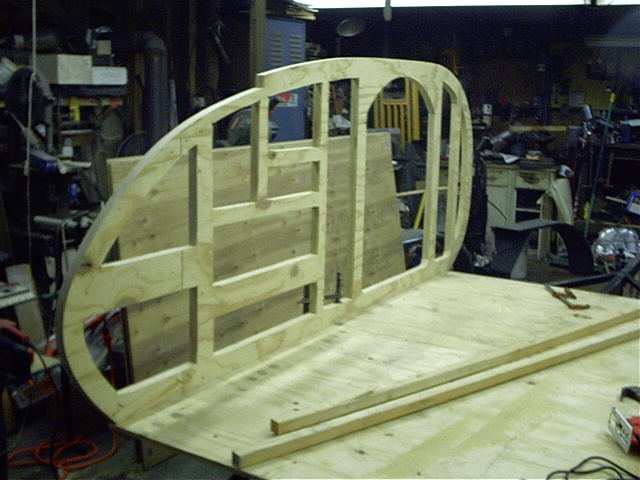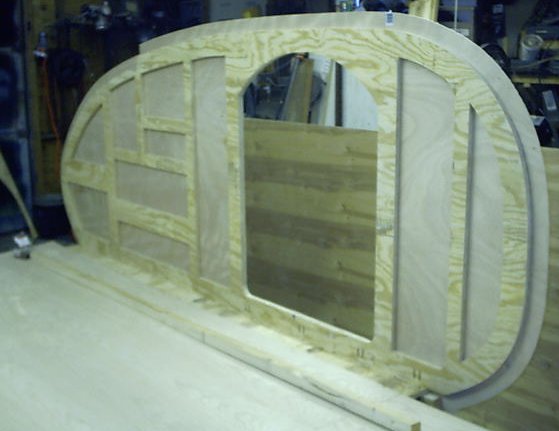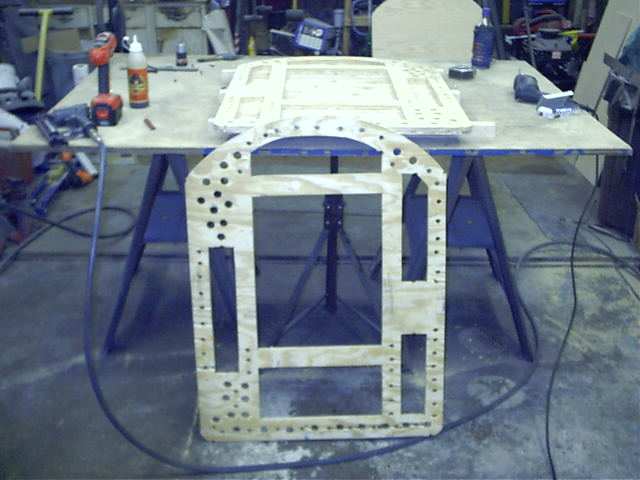Page 1 of 2
Sidewall construction savvy with roof regards

Posted:
Fri Aug 28, 2009 7:24 pmby regis101
Hello. Or... what's the best way to build a Teardrop trailer. Here are my thoughts.
I've been doing all of the reading that I can about Tear construction. From general info on the web to sdtripper2's plethora of info to using the search function on these forums.
It seems that the end result is strength and low weight. I'd like to know an order of preference to solve these two issues. There has to be compromise.
I haven't started my build for a 4 x 8 tear shaped cargo trailer. But it will happen in the next coupla weeks. I would like to build something with the option of having a galley added later.
Here's my guesses.
To build a stick frame from 1 x 2's and other similar dimensional lumber with 1/8 - 1/4" skin should produce the lightest. Might be the weakest.
To build with 1/2" 5 ply decent plywood. Walls and floor. Cleats or metal angle to help secure the walls to the floor should be doable and fairly light in weight.
To build with 3/4" 7 ply decent plywood, 1/2" 5 ply flooring. Would be the heaviest but may be the strongest.
To build by taking 3/4" plywood and cutting out the frame work similar to option one stick frame with 1/8-1/4" skin is another option. Might be the best of both worlds.
To jump ahead a bit, the roof construction should be a factor regarding side wall construction. Some Tear builders have an area with a flat roof. Spars seem to be the norm from front to back. I am of the opinion that 1/2" plywood is useable for the first 24" of vertical for those who build with this design. 5 ply plywood can also be used for the flat roof section.
The result should be a strong exoskeleton or shell.
I could use a lil help as to any appropriate threads that I may have overlooked.
I was at Lowe's today. The plywood choices are poor. The best they had was 1/2" 5 ply hardwood, 3/4" 7 ply hardwood with either an oak or birch finish. These were the straightest choices. The top 3 sheets of the 1/4" stuff was bowed. The 1 x 2's and most of the 2 x 2's were twisted. I did see bundled packs of 2 x 2's that seemed pretty straight. So there is hope.
Thanks,

Posted:
Fri Aug 28, 2009 11:28 pmby regis101
Here is a link to a local plywood supplier
http://www.earthsourcewood.com/products.aspx
Does anything look good from a weight vs strength viewpoint.

Posted:
Sat Aug 29, 2009 12:25 amby doug hodder
If'n it were me...I'd get the driest material possible to begin with. I'd get the straightest kiln dried 2x4's, 1 by pine or whatever and rip my own roof stringers out of that. Some of that pre-cut big box stuff is cranked out and not necessarily cured for what you want. Once it starts to dry well, you just might have some problems to deal with. Doug

Posted:
Sat Aug 29, 2009 1:26 amby teardrop_focus
reege
To build by taking 3/4" plywood and cutting out the frame work similar to option one stick frame with 1/8-1/4" skin is another option. Might be the best of both worlds.
I've seen at least one member here build his sidewalls this way.
Rich/Nitetimes has:



He even lightened his ply-frame sandwich doors.

A well-built, good-looking teardrop attracts hot-looking women, too. The proud builder:



Re: Sidewall construction savvy with roof regards

Posted:
Sat Aug 29, 2009 6:12 amby oldtamiyaphile
It all comes down to design. Personally, I think 3/4" sides are just too heavy, use them only if speed of construction is a major factor. I was going to use sheet sides on my build, and even with a six January deadline, I've decided to build a framed construction. Using foam insulation as part of the structure. Probably 1/8" skin as there will be alloy bonded to that.
Lightening by cutting out the ply sides seems like a lot of work, and a lot of material waste. I would only do this if I was getting the sides laser/cnc cut. The advantage of ply is that it is strong in both directions, and this advantage is lost if you use it for stringers, which are only stressed in one direction.
After researching how some caravans are built in Europe (here in Oz our 'vans seem to be a bit more robust), they use a steel chassis that is just two rails, the only cross member is the torsion axle. Walls are laminated styrofoam, with no structure behind them. Try a search for 'caravan factory' etc on YouTube for some interesting insight.
I'm at a point now where I wonder if my trailer will be blown off the road when a truck passes...should be around 600lbs fully loaded for a 4.5x8.

Posted:
Sat Aug 29, 2009 6:32 amby BrwBier
No matter what technique you use to build the walls, the strength of the whole assembly comes from the curved roof. Think egg, thin, light, strong. When I laid the 1/8" ply on the walls I was surprised how unmovable everything became.
Brwbier

Posted:
Sat Aug 29, 2009 6:54 amby Rock
After building a Pygmy kayak (
http://www.pygmyboats.com/Construction.htm) I can't believe that there is a stronger lighter construction method (this side of aerospace materials). JMHO - no data available.
Using thin plywood, covered with fiberglass cloth embedded in epoxy, joints/corners reinforced with thickened epoxy fillets, overlaid with fiberglass tape/cloth. My 17' boat weighs 40 pounds.
My camper walls are 4mm ply on the outside, framed with 3/4" whitewood (pine/fir?), 1/8" ply on the inside, insulated with extruded polystyrene (blueboard), epoxy inside, fiberglass and epoxy outside. The floor is framed with 1.5" square framing lumber, 1/4" ply top and bottom, epoxy and fiberglass top and bottom. The roof is 1/8" ply and epoxy inside, 3/4" by 1.5" whitewood spars, 4mm ply outside with epoxy and fiberglass. Wherever possible joints are reinforced with epoxy and fiberglass tape.
It's yet to see the road, but based on how my kayak performs, it just seems bulletproof, largely due to it's light weight.
Eric

Posted:
Sat Aug 29, 2009 10:57 amby regis101
Nice link to the Pygmy boats. I was unaware that using the fiberglass cloth and resin could add satisfactory strength.
Using 3/4 plywood to cut out the frame is nice. albeit lots of waste.
Thanks for the tips and experiences.

Posted:
Sat Aug 29, 2009 12:07 pmby cokebottle10
The larger the piece of wood the closer to the center of the log it came from. A 2X12 usually has no knots in it. If you rip down what you need from larger pieces then you should end up with better wood than you can buy at the big box stores. Even if you got your larger wood from the big box store in the first place.
I live in the south and have noticed that the big box stores do not carry 2X4s in southern yellow pine anymore. You have to go to a 2X6 to get it. They all seem to carry white pine 2X4s. I do not know how you can make a load bearing wall in a house with white pine 2X4s.
Thanks,
David.

Posted:
Sun Aug 30, 2009 9:13 pmby kennyrayandersen
Keep in mind that a lot of the waviness of the thinner plywood will straighten out once you nail it all down (even if it’s just to the framing – this would be especially true of you use your shop vac and bond the skins to the frame and core). For instance, on the roof – when you start curving the thin plywood any warp in the other direction will instantly disappear.
Too strong is the enemy of strong enough. As noted in an earlier post, if you see how commercial trailers are build you’d be freaked – VERY light-weight; yet, they last years without too much trouble (unless water gets in, which IMO, is a much bigger threat than strength issues (for every one that fails in strength, dozens fail due to water damage or corrosion (frame)).
There is always a battle between weight, cost and ease of manufacturing – this is life. The sandwich structure does offer the advantage of insulating the tear, which thing ¾ plywood would hardly do. You really just got to decide what’s important to you and what you are willing to pay for it in time and money. I know I will use some type of sandwich construction, though I’m vacillating a bit on exactly what – it depends on who posted a really nice picture of that particular material that day – there are some many nice examples of each it can be a bit tough to decide). For me though, in the end, I’m a bit of a weight weenie, so I will be building VERY light and no part will go on before it is scrutinized for weight and to make sure it is part of the structure.

Posted:
Sun Aug 30, 2009 9:46 pmby aggie79
kennyrayandersen wrote:Keep in mind that a lot of the waviness of the thinner plywood will straighten out once you nail it all down (even if it’s just to the framing – this would be especially true of you use your shop vac and bond the skins to the frame and core).
It will straighten out only if it is on a flat surface when you are applying the skin.
I am using 3/4 MDO plywood "framing" with skins both sides. While there is a lot of waste in this method, the plywood doesn't cup, twist and/or warp like stick built framing has a tendency to do.

Posted:
Sun Aug 30, 2009 9:53 pmby kennyrayandersen
aggie79 wrote:kennyrayandersen wrote:Keep in mind that a lot of the waviness of the thinner plywood will straighten out once you nail it all down (even if it’s just to the framing – this would be especially true of you use your shop vac and bond the skins to the frame and core).
It will straighten out only if it is on a flat surface when you are applying the skin.
I am using 3/4 MDO plywood "framing" with skins both sides. While there is a lot of waste in this method, the plywood doesn't cup, twist and/or warp like stick built framing has a tendency to do.
That's true, but I'm not sure how else you would do it except to suck a vacuum on it when it's flat on a table. Your suggested method will certainly work as well. I guess the point being is that the thin plywood warps a bit, but because it’s thin, it will also straighten out fairly easily. It looks worse than it is.

Posted:
Sun Aug 30, 2009 10:41 pmby Wolfgang92025
Regis,
I'm in the process of build my tear. I used sandwich construction. 1/4" exterior, 1/8" interior with 3/4" framing filled with Pink insulation panels.
The trailer is a 5 x 12 and each side weights 72 lbs. I used 3/4" MDF on top of my trailer floor to create a flat work surface. My garage floor is not flat. Found that out the hard way on a previous project gluing up a book shelf.

I used an old weight set to hold things together while the glue tried. The only real drawback is you need to know exactly were you are attaching everything on the wall. Take lots of pictures so you can lock back and measure on the foto's if you are not sure of location to attach stuff.
Wolfgang

Posted:
Sun Aug 30, 2009 10:51 pmby regis101
5 x 12 and only weighs 72#. Impressive. I suppose that the pink panels also get a spread of glue?

Posted:
Sun Aug 30, 2009 11:29 pmby kennyrayandersen
regis101 wrote:5 x 12 and only weighs 72#. Impressive. I suppose that the pink panels also get a spread of glue?
each side weighed 72#
If you bond it up, you could get by with 1/8 on both facesheets if the joints at the corners are well done.
Still, this is one reason the fiberglass looks so attractive -- it's lighter than the 1/8 inch ply for equivalent strength.


